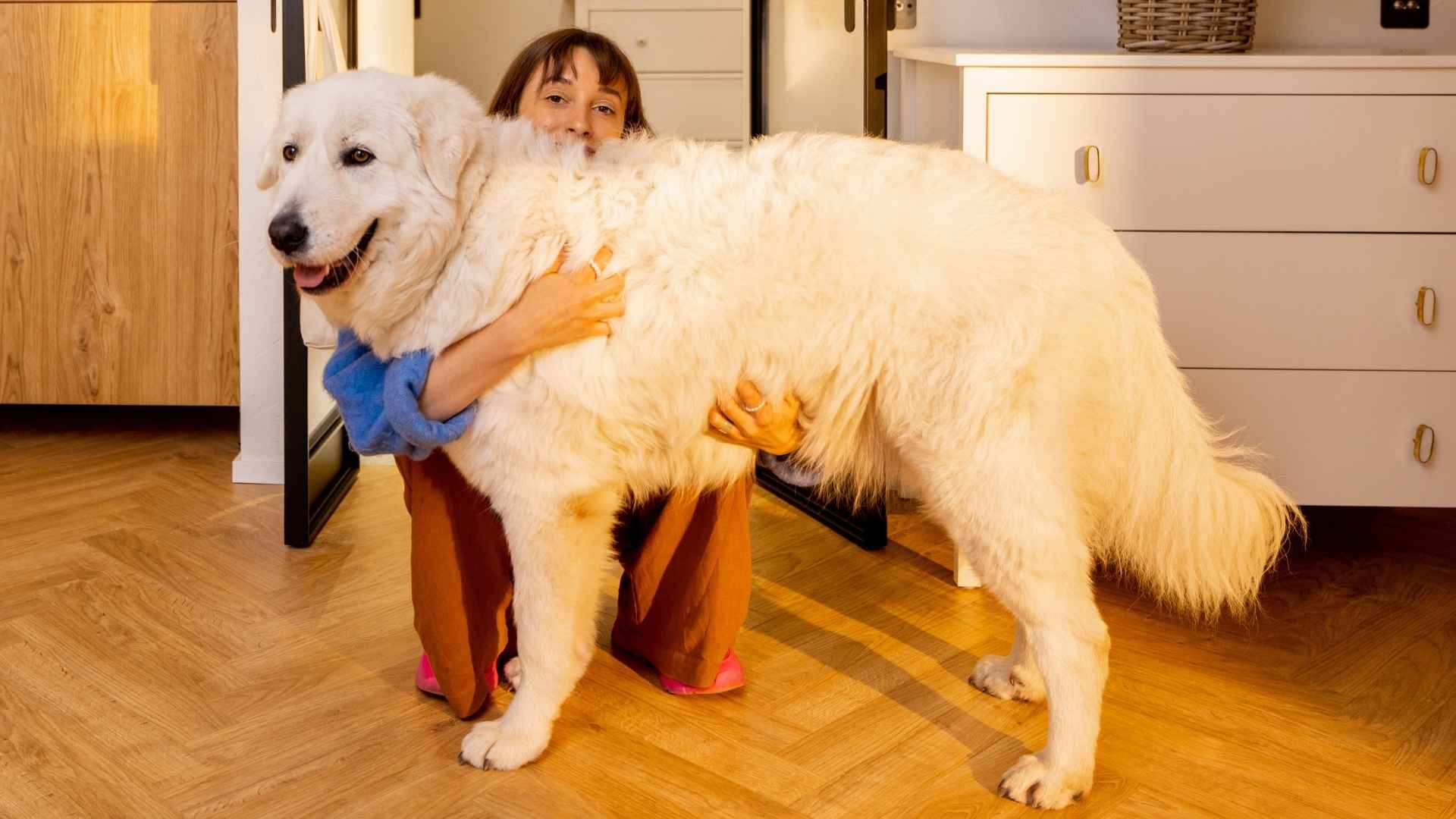Did you know that the largest dog in the world weighed over 343 pounds? Giant dogs are truly a sight to behold, standing tall and commanding attention wherever they go. But despite their impressive size, many of these colossal canines are known for their gentle, affectionate nature.
While they may require a little extra space and care, their loyalty and companionship make them beloved members of families worldwide. From their towering presence to their heartwarming personalities, giant dogs are a perfect blend of strength and sweetness. Whether they’re serving as protectors, working alongside humans, or simply lounging on the couch, these massive breeds are much more than their size suggests.
In this blog, we’ll dive into the world of giant dog breeds, exploring their unique qualities, temperament, and why they might just be the perfect fit for your home.
Giant Dog Breeds
1. Anatolian Shepherd
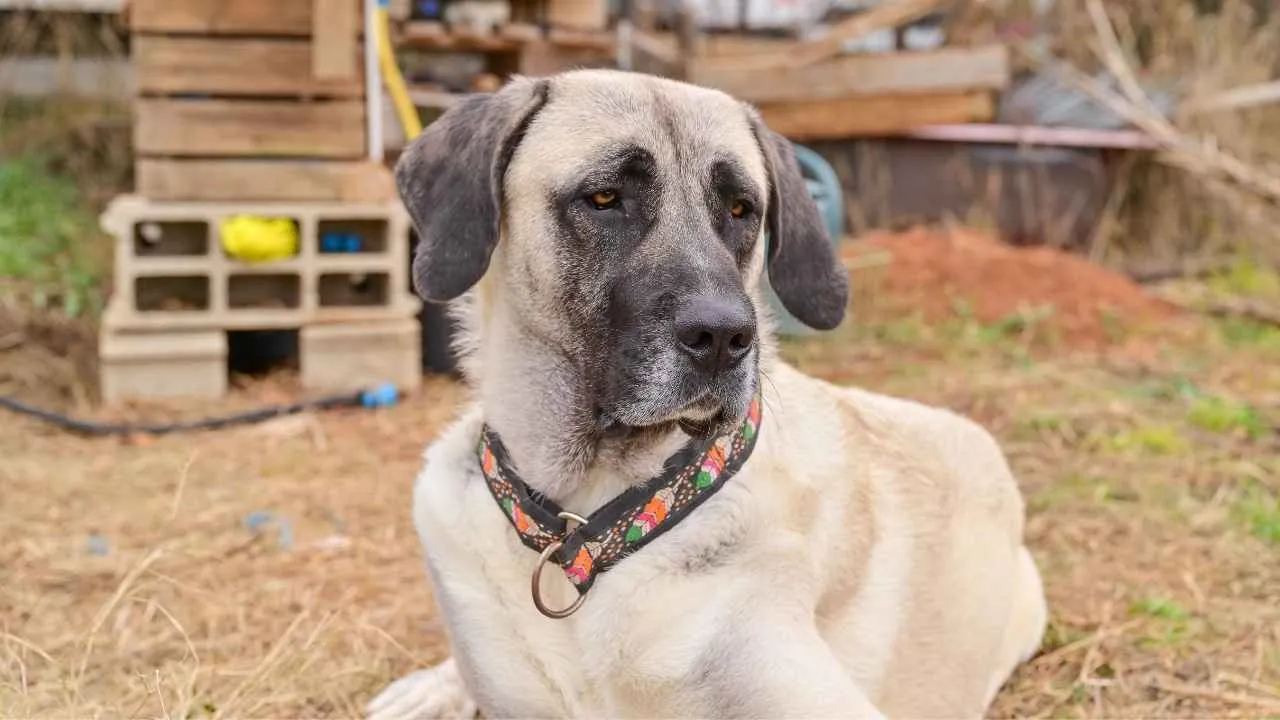
The Anatolian Shepherd Dog is a powerful and ancient livestock guardian breed from Turkey, developed to withstand harsh climates and fend off predators. With roots tracing back over 6,000 years, this rugged, no-nonsense breed was built for independence and endurance in the unforgiving terrain of Anatolia.
Loyal, intelligent, and naturally protective, Anatolians guard everything they consider part of their flock, including children and other pets. While calm with family, they require strong, experienced owners who can manage their dominant and independent nature.
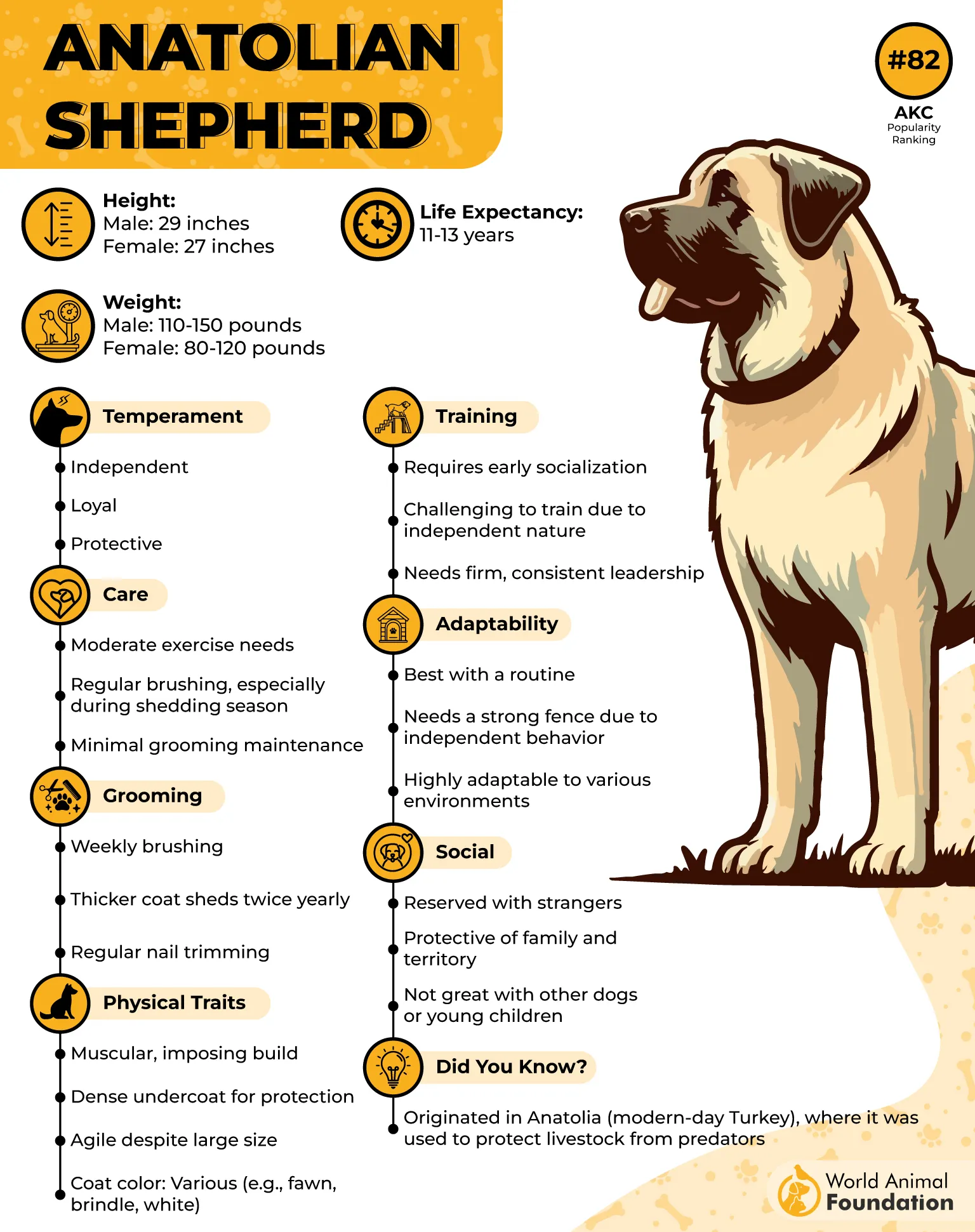
Towering at up to 29 inches and weighing as much as 150 pounds, the Anatolian Shepherd stands firmly among the giant breeds, with females only slightly smaller but equally imposing in stature.
Although known in Turkey for centuries, the breed wasn’t exported until the mid-1900s. AKC states that they arrived in the U.S. through a failed government program in the 1930s and later gained recognition in the 1970s as non-lethal livestock protectors under the Endangered Species Act.
Today, Anatolians play a unique role in conservation. In Namibia, they help protect livestock from predators like cheetahs, reducing farmer-wildlife conflict by up to 100%. Their presence continues to serve both traditional agriculture and global wildlife preservation efforts.
2. Great Pyrenees
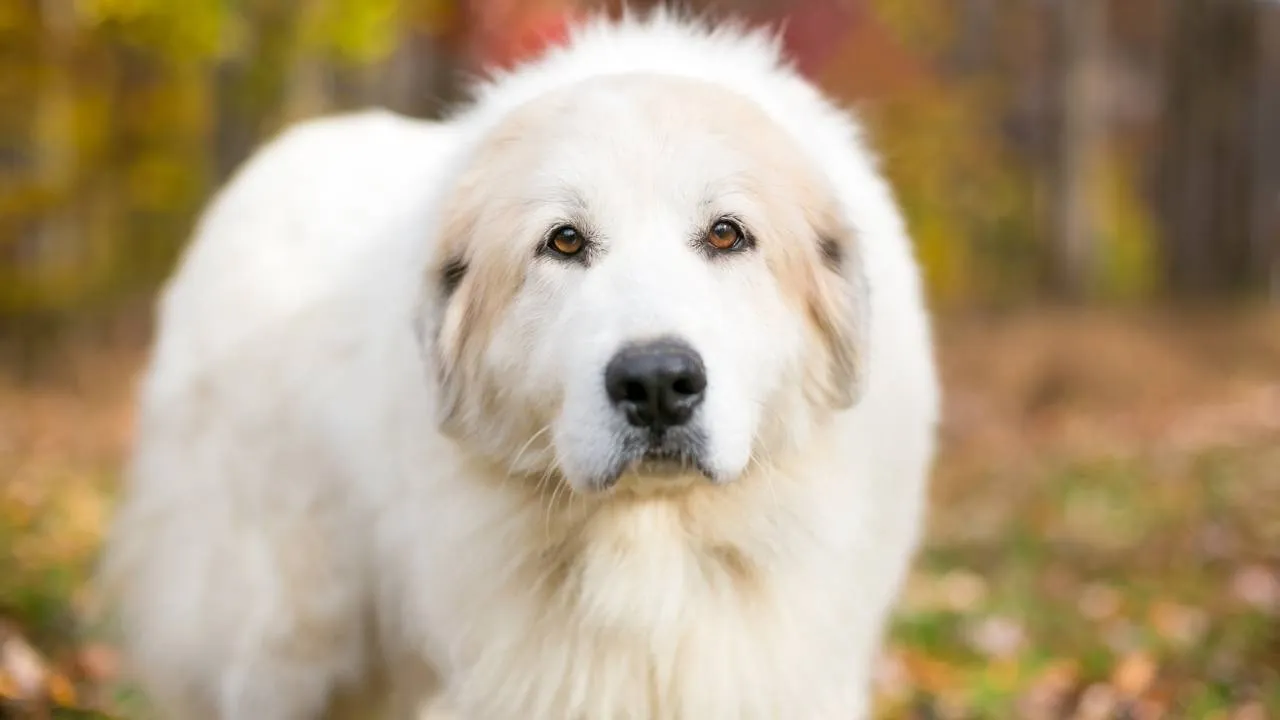
The Great Pyrenees is a giant breed originally developed in the Pyrenees Mountains between France and Spain to serve as a livestock guardian. Males typically reach 27 to 32 inches in height and weigh over 100 pounds, while females measure between 25 and 29 inches tall and weigh at least 85 pounds. Farmers historically paired the Great Pyrenees with the smaller Pyrenean Shepherd—while the Shepherd herded the flock, the larger Pyrenees protected livestock from predators like wolves and bears.
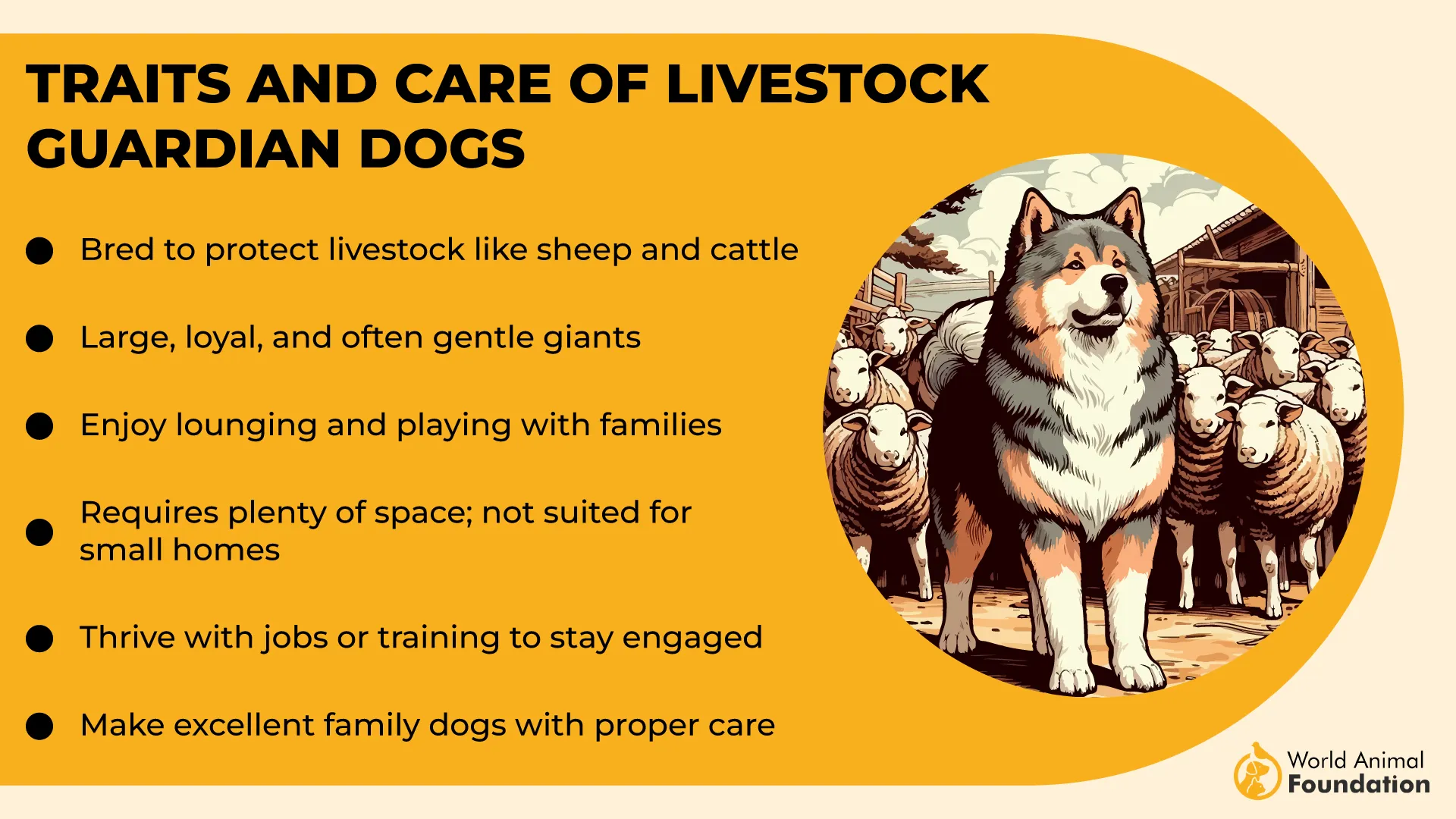
These dogs have long fulfilled two primary working roles. As “Ranch or Farm Dogs,” they stay near the farmhouse, acting as both family guardians and protectors of animals grazing close to home. In contrast, “Livestock Guardian Dogs” live exclusively with the herd in isolated pastures, fully dedicated to protecting livestock without functioning as household pets.
In either role, Great Pyrenees effectively guard their territory and are even known to extend their protection to neighboring pastures when needed.
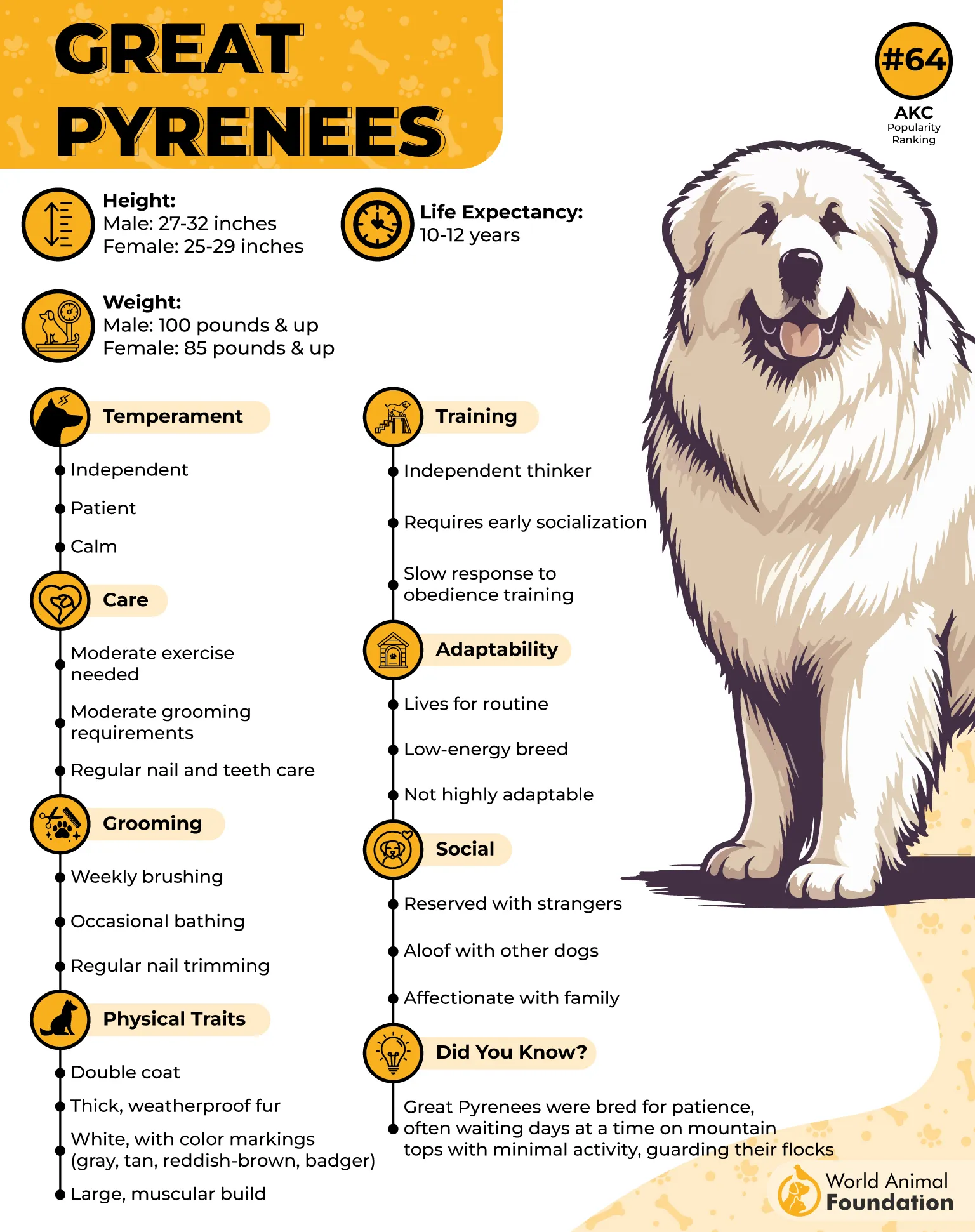
AKC states the Great Pyrenees is naturally nocturnal. Modern owners can expect these dogs to be more active at night, frequently barking to deter potential intruders—an instinct that also makes them reliable watchdogs. Their strong protective instincts extend to families, especially children, though their tendency to misinterpret rough play as aggression means supervision is important.
While once a staple of peasant farms, the breed eventually gained favor with the French nobility. Historical records from the 15th century mention their use as castle guardians, and by 1675, King Louis XIV had declared the Great Pyrenees the Royal Dog of France. Their combination of strength, loyalty, and protective ability contributed to their enduring reputation, even playing a key role in reviving the dwindling St. Bernard population in 1870.
They thrive best in households that can accommodate their need for space, activity, and a sense of purpose. Proper management, training, and awareness of their nocturnal habits help ensure the Great Pyrenees remains both a devoted family companion and an effective guardian.
3. Irish Wolfhound
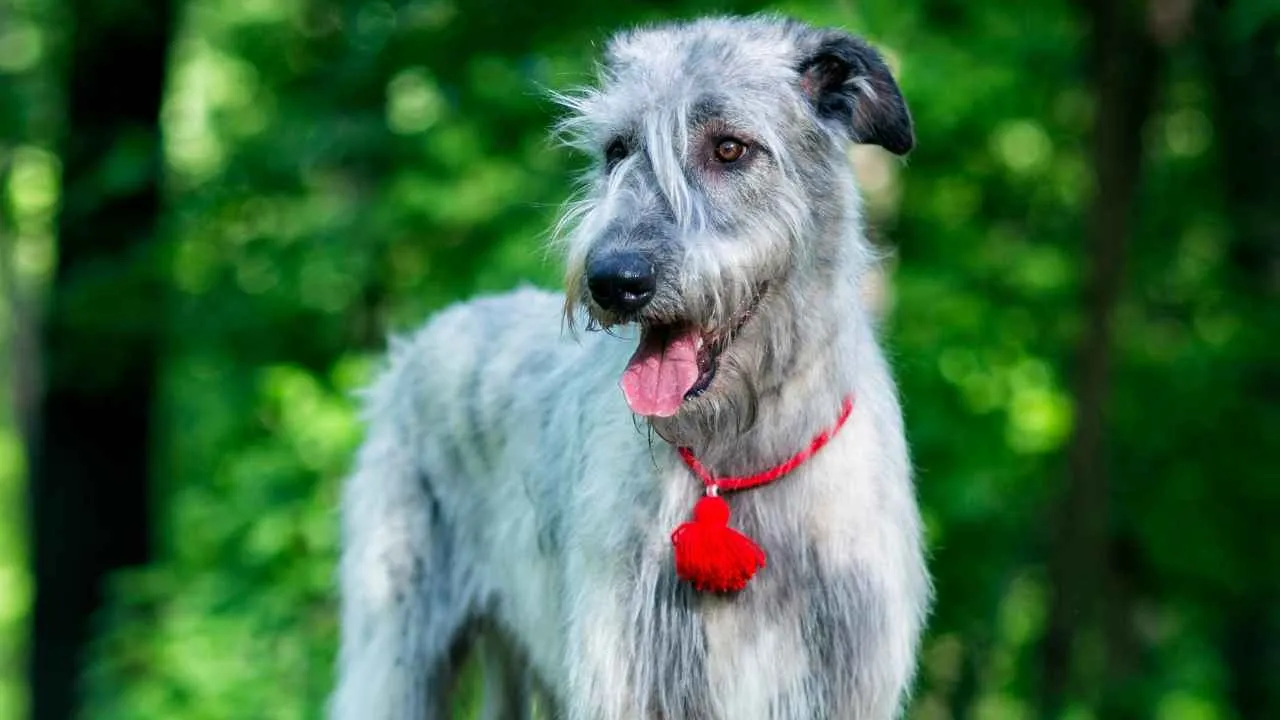
The Irish Wolfhound, the tallest dog breed in the world, stands at least 32 inches at the shoulder, with males reaching over 7 feet on their hind legs. Despite their imposing size, they have a greyhound-like build—long-legged, deep-chested, and moderately narrow-waisted—ideal for strength and speed, traits originally bred for hunting large game.
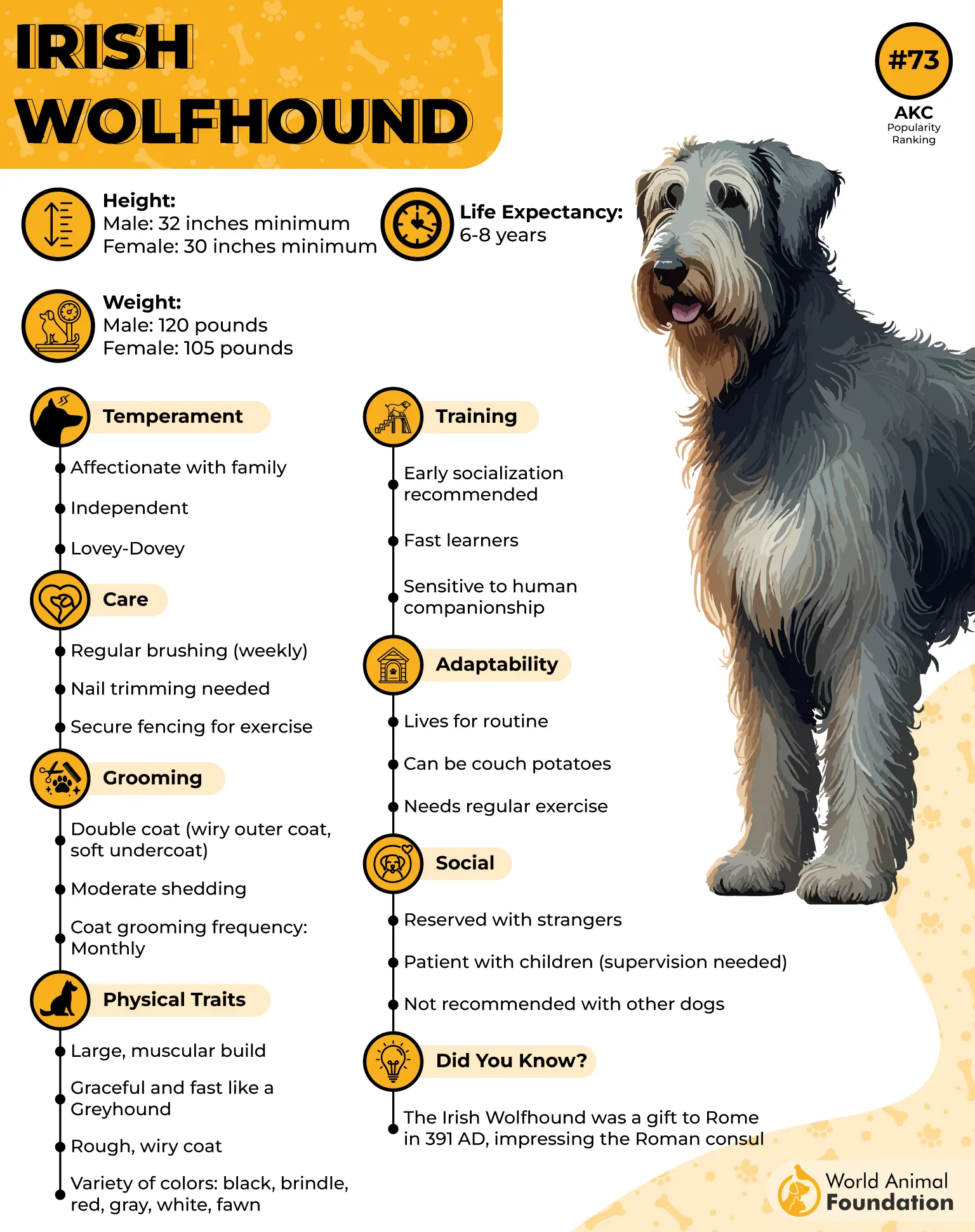
As sighthounds, they have a strong instinct to chase, requiring exercise in securely enclosed spaces. While they can be laid-back as adults, they benefit from regular physical activity and enjoy dog sports like lure coursing and agility. A spacious, fenced yard is essential to accommodate their hunting drive.
Irish Wolfhounds are calm, noble, and affectionate, making them excellent companions for families and other pets. Though their size can be intimidating, they are not aggressive and lack territorial instincts. Their intelligence and independence may make them slow to obey, but they are generally well-mannered.
With a wiry double coat, often graying, and available in various colors, these dogs maintain a rugged appearance. Though gentle and docile at home, their hunting instinct remains strong outdoors, so careful supervision is necessary, particularly around smaller animals.
4. Leonberger
The Leonberger, a majestic giant breed from Leonberg, Germany, was bred in the 17th century to resemble the lion on the town’s coat of arms by crossing Newfoundlands, Saint Bernards, and Great Pyrenees. This large, friendly dog with a striking reddish-gold coat became popular among European royalty and has since evolved into a loyal family companion and reliable search-and-rescue dog.
Standing between 25–32 inches tall and weighing up to 170 pounds, Leonbergers have a powerful build with males often displaying a lion-like mane. Despite their grandeur, their life expectancy is around seven years due to their size. Their long double coat requires regular grooming to manage shedding and matting.
While they can suffer from joint issues like hip dysplasia and gastric dilatation-volvulus (GDV), responsible breeding practices and regular vet checkups can help mitigate these risks. Leonbergers need ample space and daily exercise, making them unsuitable for apartments. A large yard and structured activities like agility training or cart-pulling are ideal for keeping them physically and mentally engaged.
Training and early socialization are crucial, as these dogs require consistent guidance to manage their strength and size, particularly during their energetic younger years. Group obedience classes are highly recommended to ensure reliable responses to commands.
5. Newfoundland
The Newfoundland, a cherished working dog, is renowned for its swimming ability and heroic water rescue instincts. Originating in Newfoundland in the early 1800s, these dogs were vital companions to fishermen, retrieving nets, hauling carts, and saving lives.
WebMD states their sweet temperament and protective nature, especially around children, has earned them the affectionate nickname “nanny dogs.”
Physically, Newfoundlands are large, powerful dogs built for endurance. Males stand up to 28 inches tall and weigh 130–150 pounds, while females are slightly smaller. Their dense double coat insulates and protects them, keeping them warm in cold waters. Common coat colors include black, grey, brown, and white-and-black, often with white patches on their chest or paws.
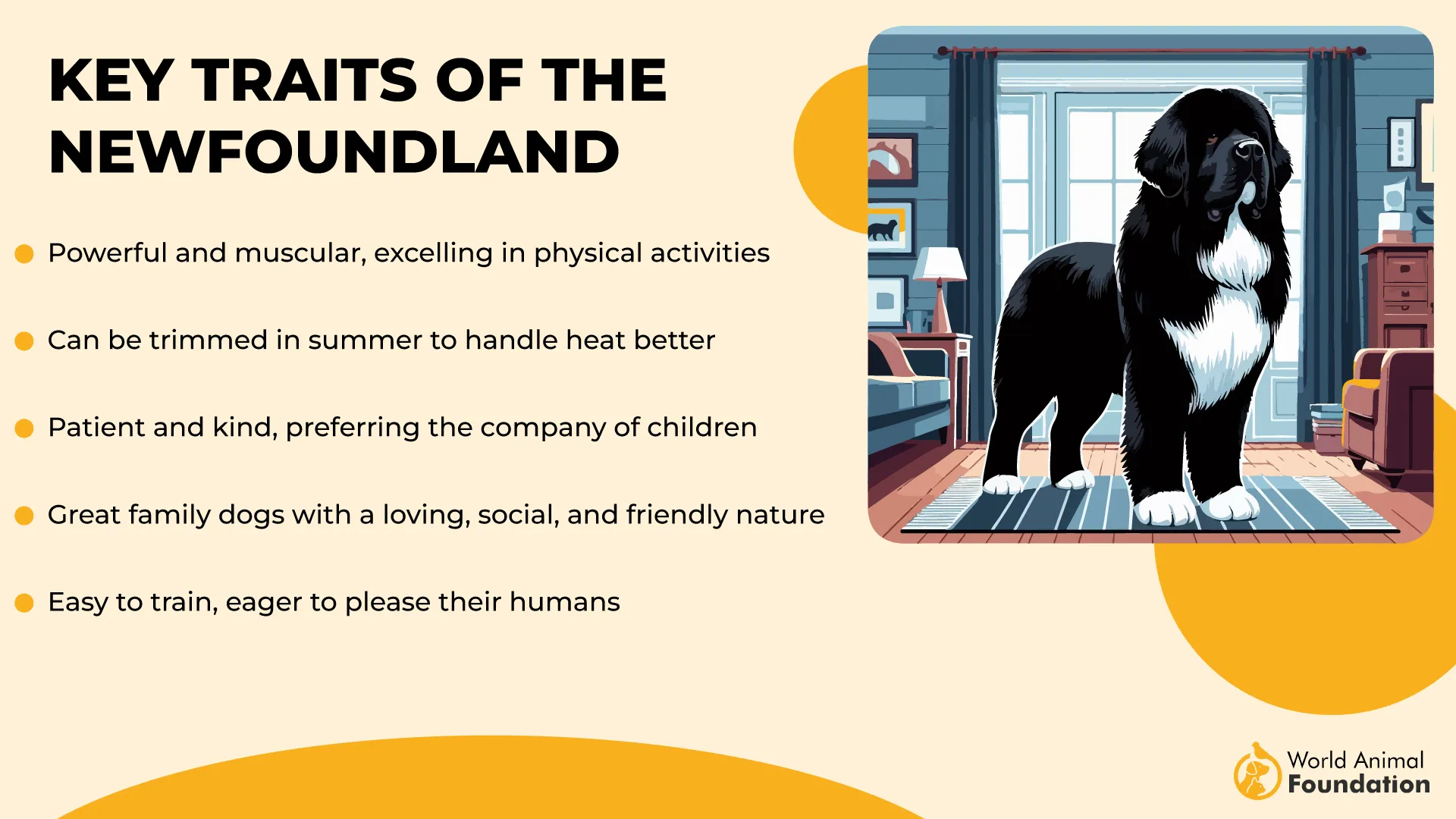
Though no longer widely used for water rescues in the U.S., Newfoundlands still engage in water and draft exercises, particularly in countries like France and Italy. Their sweet, gentle temperament makes them ideal family companions, especially for those seeking a calm, nurturing presence despite their size. The breed’s history of heroism, exemplified by “Swansea Jack,” a dog who saved over 20 people, continues to highlight their courage and loyalty.
6. Saint Bernard
The Saint Bernard, a large dog breed originally from the Swiss Alps, is renowned for its history of rescuing travelers in treacherous mountain conditions. Named after the St. Bernard Hospice, where these dogs were bred to assist monks, Saints became famous for their rescue work during avalanches and snowstorms. The breed’s physical characteristics reflect its purpose as a working dog, with powerful muscles and a massive frame. Males stand between 28 to 30 inches at the shoulder, weighing 140 to 180 pounds, while females are slightly smaller.
Saint Bernards possess a distinct appearance with a large, wrinkled head, short muzzle, and dark, intelligent eyes. Their coats are smooth or rough, with color combinations of brindle and white, brown and white, or various shades of red and white, often with a black mask. Their gentle, patient nature and imposing size make them one of the most beloved breeds, despite not ranking highly in AKC registrations.
Known for their exceptional sense of smell and navigational skills, Saint Bernards played a key role in saving stranded travelers. They were trained to track and locate individuals lost in snowstorms or buried under avalanches, often acting as both rescuers and protectors. The dogs would keep the injured person warm while sending another to alert the monastery for further help. These acts of bravery have made them iconic symbols of devotion and courage.
Saint Bernards are known for their calm and affectionate temperament, making them excellent companions for families, especially those with children. Their patience and gentle nature help them interact well with kids, and they are often referred to as “nanny dogs.” While they are friendly and tolerant, they can also be protective when they sense danger to their loved ones.
While they have been known by several names over the centuries, including Barry dogs and Alpine mastiffs, their legacy as rescue dogs and loving family pets remains unchanged, cementing their place as one of the most famous and adored breeds worldwide.
7. Scottish Deerhound
The Scottish Deerhound, known as the “Royal Dog of Scotland,” is a majestic and large coursing hound bred to hunt wild red deer in the Scottish Highlands. This majestic breed stands 28 to 32 inches at the shoulder and weighs between 75 to 110 pounds.
The breed’s noble and stately appearance is enhanced by a tapered head, long neck, and a crisp, wiry coat. While the Deerhound shares a build similar to the Greyhound, it is more substantial and imposing, with many enthusiasts preferring the dark blue-gray coat.
Originally bred in the 1500s, the Scottish Deerhound has maintained its heritage as a graceful yet powerful sighthound. Despite its impressive size, the Deerhound is gentle and affectionate, making it a beloved companion at home. Its calm and dignified demeanor is one of the breed’s defining traits, although its strong prey drive means it may chase small animals, requiring careful management of exercise and outdoor time, such as using a leash or secure fenced area.
Hillspet states that the Deerhound’s wiry coat is relatively low-maintenance, requiring only weekly brushing and occasional baths to keep it free of odor. Grooming sessions should include nail trimming and inspection for any skin issues or lumps. Regular brushing and combing will keep the coat healthy, and tools like a slicker brush, metal dog comb, and nail clippers are essential for maintaining the breed’s grooming needs.
While the Scottish Deerhound is generally easygoing, it is sensitive and responds best to positive reinforcement during training. This breed thrives on human companionship and should not be left in kennels or crates for long periods. Deerhounds are not only known for their hunting abilities but also for their ability to form strong bonds with their families, and they require regular exercise to stay mentally and physically healthy.
8. Tibetan Mastiff
The Tibetan Mastiff (TM) is an ancient and imposing breed, believed to be the progenitor of all modern mastiffs. Originally bred to guard the Himalayas, these majestic dogs were gifted to early travelers and contributed to the development of mastiff breeds across the Middle East and Europe. Known for their protective nature, TMs are calm and devoted at home but aloof and territorial with strangers, making them excellent guardians.
Tibetan Mastiffs are large, standing 26 inches tall and weighing over 100 pounds. Despite their size, they are surprisingly agile. Their broad head, expressive brown eyes, and V-shaped ears give them a noble and wise appearance. While they are vocal due to their protective instincts, barking can be managed with proper training and socialization.
Training a Tibetan Mastiff requires experience, as they are intelligent but independent and stubborn. They respond best to consistent, positive reinforcement and need clear boundaries. Early socialization is essential to help them become well-rounded and adaptable pets, ensuring they interact appropriately with different people, dogs, and environments.
These dogs are fiercely loyal and view their owners as equals. While they can tolerate being left alone for short periods, they should not be left for more than four hours to avoid anxiety and destructive behavior. Tibetan Mastiffs are naturally aloof with strangers and require socialization from a young age to adjust to new people and situations.
Tibetan Mastiffs can live well with children and other pets if raised together, but adult TMs may be less tolerant of newcomers. Due to their size, they should be supervised around smaller children and animals. They are happiest with space to roam, making them ideal for homes with large yards where they can thrive as vigilant guardians.
9. Mastiff
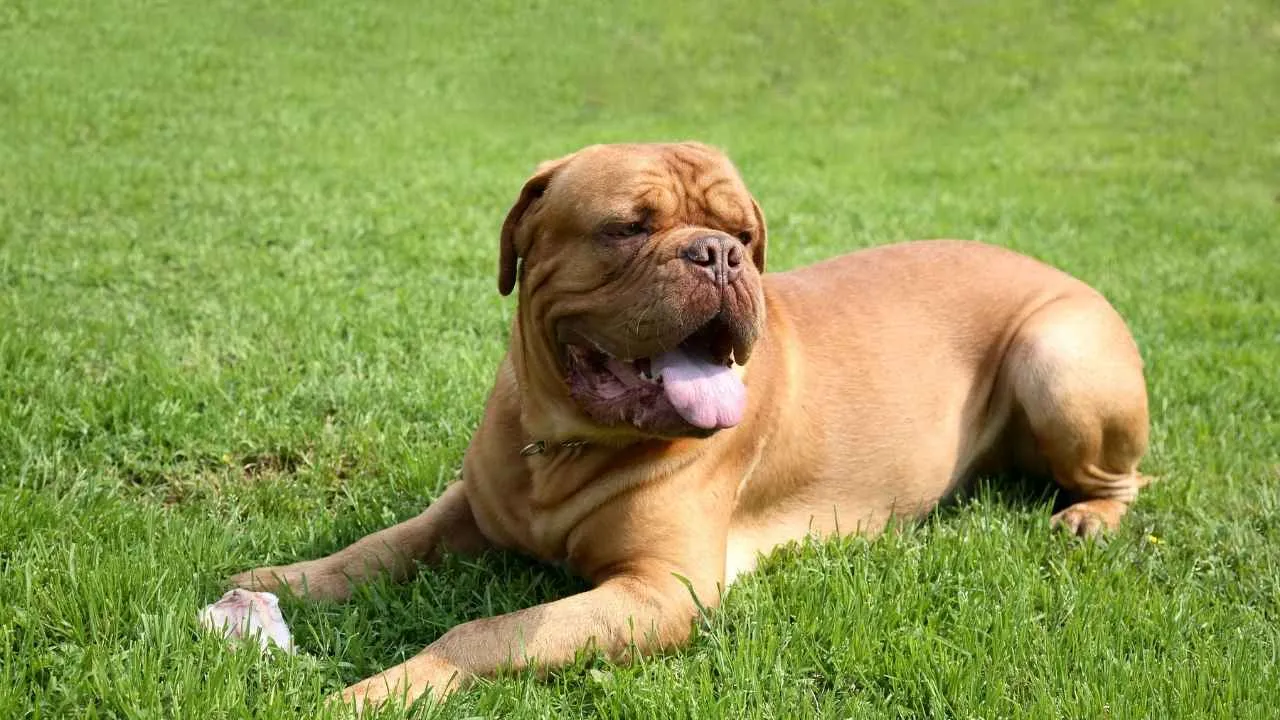
The Mastiff is one of the most ancient and valued dog breeds, with a history spanning over 2,000 years. Known for its size and strength, the breed was originally used for guarding, hunting, and as war dogs. Mastiffs were highly regarded across Europe and Asia, with records of their existence dating back to 3000 BCE. The breed’s ancestor, the Molossian, gave rise to many large dog breeds, including the English Mastiff, which was used in ancient Rome for combat in the arena, facing off against wild animals and gladiators.
Mastiffs are large, imposing dogs, standing between 27.5 and 30 inches tall and weighing 120 to 230 pounds. Due to their size, they require ample space to move and rest comfortably. They are not ideal for small living spaces, as they need soft bedding to avoid joint issues and enough room to stretch out. Additionally, the breed’s large appetite and drooling make them a challenging pet to maintain for some owners.
While Mastiffs are generally low-energy and enjoy lounging in comfortable spaces, they still require around an hour of exercise daily. However, it’s crucial not to over-exercise them when they are young, as their growing bodies are prone to skeletal problems that can be worsened by strain. Mastiffs do best with moderate activity, like walks or lounging in a sunny garden.
Mastiffs are also prone to certain hereditary health conditions, such as eye disorders, hip and elbow dysplasia, and ligament problems like cruciate disease. It’s important to perform health screenings, including eye tests and hip scoring, to ensure that the dog is free of these conditions. Their large size also makes them susceptible to joint pain and other mobility issues, which should be managed with proper care.
Training and socialization are essential for Mastiffs, especially considering their size and strength. While they have a more independent nature and may not show much interest in training, they should be taught basic commands and proper leash walking. Early socialization will help them become well-mannered and manageable, ensuring they can interact safely with other dogs and people, despite their powerful build.
Conclusion
Giant dog breeds like Bernese Mountain Dogs, Great Danes, and Saint Bernards are truly remarkable due to their large stature, gentle nature, and strong sense of loyalty. These big dogs, affectionately called “gentle giants,” have long histories as working dogs, guard dogs, and loyal family companions. Their thick double coats, strong build, and intelligence make them well-suited for a variety of roles, from herding and hunting to providing protection and affection.
While their size and strength require early training, proper socialization, and enough space to roam, these dogs excel in environments where they are given enough exercise and mental stimulation. Whether it’s a Cane Corso with a strong will or a gentle, sweet-tempered Bernese Mountain Dog, adopting a giant breed comes with a commitment to their needs, including consistent training and care.
For those with the time, space, and dedication, these giant dogs can make excellent pets, offering unmatched loyalty, protection, and affection. With the right training and environment, they thrive as companions, proving that big dog breeds can be both imposing in stature and incredibly loving in temperament.


